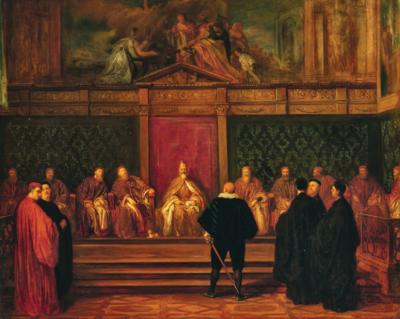Tony Robert-Fleury
(Paris 1837–1911 Viroflay/ Seine-et-Oise)
“Le Senat de Venise”, verso old title and inscription “Robert Fleury, appartient à M. Conteaux”, signed, dated Robert Fleury 1849, oil on panel, 68.5 x 84.5 cm, framed (frame damaged)
Provenance:
Sale, Dorotheum, Vienna, 26 October 1935, Lot 867;
Private Collection, Vienna.
Tony Robert-Fleury here captures an audience with Doge Marino Grimani (1532-1605) in the Sala del Collegio of the Doge's Palace in Venice.
The magnificent Sala del Collegio was the assembly hall of the Pien Collegio, the government of the Republic of Venice presided over by the Doge. In addition to the Doge, this consisted of the Signoria (the Small Council), the Quarantia (Council of Forty/Supreme Court) and the Savi (Councillors of the Wise). The duties of the Pien Collegio, which met on a daily basis, included the discussion of political, military and economic issues as well as the reception of foreign envoys. The wooden seats in the hall date back to 1574, after the room was renovated following a fire in the same year. A large painting by Paolo Veronese depicting Doge Sebastiano Venier giving thanks for the victorious Battle of Lepanto in 1581 occupies the space above the tribunal.
Robert-Fleury's work recalls a Renaissance painting by Pietro Malombra depicting an audience of the Spanish ambassador with Doge Marino Grimani in the Sala del Collegio in 1604, which is in the Museo del Prado in Madrid.
Grimani’s presence as a patron of art and culture is still felt in Venice today; numerous art and book collections bear his name. He also had an enormous influence on the design of the Doge’s Palace, so much so that one of the audience rooms, the Sala Grimani, was named after him. The Doge had himself portrayed in several paintings in the palace. His family was one of the most respected and wealthiest in Venice. The former family palace, the magnificent Palazzo Grimani, is located not far from the Rialto Bridge on the Grand Canal. Marino Grimani was elected Doge in 1595 and was popular with the people because of his generosity. Leopold von Ranke wrote about him: "Never has the death of a doge been more deeply and universally mourned than that of Grimani in 1605."
Specialist: Mag. Dimitra Reimüller
 Mag. Dimitra Reimüller
Mag. Dimitra Reimüller
+43-1-515 60-355
19c.paintings@dorotheum.at
25.04.2024 - 18:00
- Estimate:
-
EUR 7,000.- to EUR 10,000.-
Follow Remove
Tony Robert-Fleury
(Paris 1837–1911 Viroflay/ Seine-et-Oise)
“Le Senat de Venise”, verso old title and inscription “Robert Fleury, appartient à M. Conteaux”, signed, dated Robert Fleury 1849, oil on panel, 68.5 x 84.5 cm, framed (frame damaged)
Provenance:
Sale, Dorotheum, Vienna, 26 October 1935, Lot 867;
Private Collection, Vienna.
Tony Robert-Fleury here captures an audience with Doge Marino Grimani (1532-1605) in the Sala del Collegio of the Doge's Palace in Venice.
The magnificent Sala del Collegio was the assembly hall of the Pien Collegio, the government of the Republic of Venice presided over by the Doge. In addition to the Doge, this consisted of the Signoria (the Small Council), the Quarantia (Council of Forty/Supreme Court) and the Savi (Councillors of the Wise). The duties of the Pien Collegio, which met on a daily basis, included the discussion of political, military and economic issues as well as the reception of foreign envoys. The wooden seats in the hall date back to 1574, after the room was renovated following a fire in the same year. A large painting by Paolo Veronese depicting Doge Sebastiano Venier giving thanks for the victorious Battle of Lepanto in 1581 occupies the space above the tribunal.
Robert-Fleury's work recalls a Renaissance painting by Pietro Malombra depicting an audience of the Spanish ambassador with Doge Marino Grimani in the Sala del Collegio in 1604, which is in the Museo del Prado in Madrid.
Grimani’s presence as a patron of art and culture is still felt in Venice today; numerous art and book collections bear his name. He also had an enormous influence on the design of the Doge’s Palace, so much so that one of the audience rooms, the Sala Grimani, was named after him. The Doge had himself portrayed in several paintings in the palace. His family was one of the most respected and wealthiest in Venice. The former family palace, the magnificent Palazzo Grimani, is located not far from the Rialto Bridge on the Grand Canal. Marino Grimani was elected Doge in 1595 and was popular with the people because of his generosity. Leopold von Ranke wrote about him: "Never has the death of a doge been more deeply and universally mourned than that of Grimani in 1605."
Specialist: Mag. Dimitra Reimüller
 Mag. Dimitra Reimüller
Mag. Dimitra Reimüller
+43-1-515 60-355
19c.paintings@dorotheum.at
|
Buyers hotline
Mon.-Fri.: 10.00am - 5.00pm
kundendienst@dorotheum.at +43 1 515 60 200 |
| Auction: | 19th Century Paintings |
| Auction type: | Saleroom auction with Live Bidding |
| Date: | 25.04.2024 - 18:00 |
| Location: | Vienna | Palais Dorotheum |
| Exhibition: | 13.04. - 25.04.2024 |

